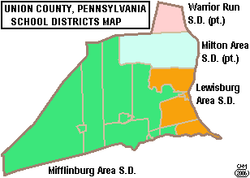Union County, Pennsylvania | |
|---|---|
 Old Union County Courthouse in New Berlin | |
 Location within the U.S. state of Pennsylvania | |
| Coordinates: 40°58′N77°04′W / 40.96°N 77.06°W | |
| Country | |
| State | |
| Founded | March 22, 1813 |
| Seat | Lewisburg |
| Largest borough | Lewisburg |
| Area | |
• Total | 318 sq mi (820 km2) |
| • Land | 316 sq mi (820 km2) |
| • Water | 1.8 sq mi (4.7 km2) 0.6% |
| Population (2020) | |
• Total | 42,681 |
| • Density | 142/sq mi (55/km2) |
| Time zone | UTC−5 (Eastern) |
| • Summer (DST) | UTC−4 (EDT) |
| Congressional district | 15th |
| Website | unionco |
Union County is a county in the Commonwealth of Pennsylvania. As of the 2020 census, the population was 42,681. [1] Its county seat is Lewisburg. [2] The county was created on March 22, 1813, from part of Northumberland County. Its name is an allusion to the federal Union. Mifflinburg was established by legislation as the first county seat until it was moved to New Berlin in 1815. Lewisburg became county seat in 1855 and has remained so since. Union County comprises the Lewisburg, PA Micropolitan Statistical Area, which is also included in the Bloomsburg-Berwick-Sunbury, PA Combined Statistical Area. The county is part of the Central Pennsylvania region of the state. [a]
Contents
- Geography
- Adjacent counties
- State protected areas
- Major highways
- Demographics
- 2020 census
- Micropolitan Statistical Area
- Government
- County commissioners
- State government
- Federal level
- Politics
- Education
- Public school districts
- Vocational school
- Higher education
- Private schools
- Communities
- Boroughs
- Townships
- Census-designated places
- Population ranking
- See also
- References
- External links



